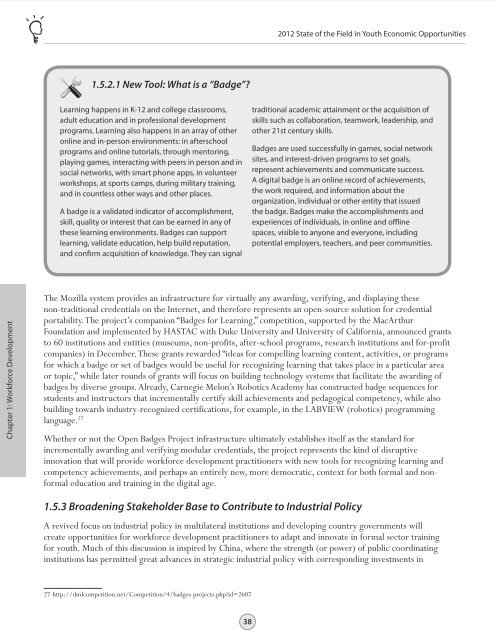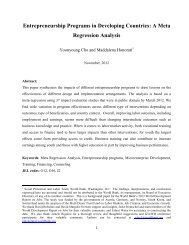STATE OF THE FIELD IN YOUTH ECONOMIC OPPORTUNITIES
STATE OF THE FIELD IN YOUTH ECONOMIC OPPORTUNITIES
STATE OF THE FIELD IN YOUTH ECONOMIC OPPORTUNITIES
You also want an ePaper? Increase the reach of your titles
YUMPU automatically turns print PDFs into web optimized ePapers that Google loves.
Table of Contents<br />
Chapter 1 Chapter 2 Chapter 3 Chapter 4 Chapter 5 Chapter 6 Chapter 7 Chapter 8<br />
Chapter 9<br />
Chapter 10 Chapter 11 Chapter 12 Chapter 13 Chapter 14 Chapter 15 Annexes<br />
2012 State of the Field in Youth Economic Opportunities<br />
1.5.2.1 New Tool: What is a “Badge”<br />
Learning happens in K-12 and college classrooms,<br />
adult education and in professional development<br />
programs. Learning also happens in an array of other<br />
online and in-person environments: in afterschool<br />
programs and online tutorials, through mentoring,<br />
playing games, interacting with peers in person and in<br />
social networks, with smart phone apps, in volunteer<br />
workshops, at sports camps, during military training,<br />
and in countless other ways and other places.<br />
A badge is a validated indicator of accomplishment,<br />
skill, quality or interest that can be earned in any of<br />
these learning environments. Badges can support<br />
learning, validate education, help build reputation,<br />
and confirm acquisition of knowledge. They can signal<br />
traditional academic attainment or the acquisition of<br />
skills such as collaboration, teamwork, leadership, and<br />
other 21st century skills.<br />
Badges are used successfully in games, social network<br />
sites, and interest-driven programs to set goals,<br />
represent achievements and communicate success.<br />
A digital badge is an online record of achievements,<br />
the work required, and information about the<br />
organization, individual or other entity that issued<br />
the badge. Badges make the accomplishments and<br />
experiences of individuals, in online and offline<br />
spaces, visible to anyone and everyone, including<br />
potential employers, teachers, and peer communities.<br />
Chapter 1: Workforce Development<br />
The Mozilla system provides an infrastructure for virtually any awarding, verifying, and displaying these<br />
non-traditional credentials on the Internet, and therefore represents an open-source solution for credential<br />
portability. The project’s companion “Badges for Learning,” competition, supported by the MacArthur<br />
Foundation and implemented by HASTAC with Duke University and University of California, announced grants<br />
to 60 institutions and entities (museums, non-profits, after-school programs, research institutions and for-profit<br />
companies) in December. These grants rewarded “ideas for compelling learning content, activities, or programs<br />
for which a badge or set of badges would be useful for recognizing learning that takes place in a particular area<br />
or topic,” while later rounds of grants will focus on building technology systems that facilitate the awarding of<br />
badges by diverse groups. Already, Carnegie Melon’s Robotics Academy has constructed badge sequences for<br />
students and instructors that incrementally certify skill achievements and pedagogical competency, while also<br />
building towards industry-recognized certifications, for example, in the LABVIEW (robotics) programming<br />
language. 27<br />
Whether or not the Open Badges Project infrastructure ultimately establishes itself as the standard for<br />
incrementally awarding and verifying modular credentials, the project represents the kind of disruptive<br />
innovation that will provide workforce development practitioners with new tools for recognizing learning and<br />
competency achievements, and perhaps an entirely new, more democratic, context for both formal and nonformal<br />
education and training in the digital age.<br />
1.5.3 Broadening Stakeholder Base to Contribute to Industrial Policy<br />
A revived focus on industrial policy in multilateral institutions and developing country governments will<br />
create opportunities for workforce development practitioners to adapt and innovate in formal sector training<br />
for youth. Much of this discussion is inspired by China, where the strength (or power) of public coordinating<br />
institutions has permitted great advances in strategic industrial policy with corresponding investments in<br />
27 http://dmlcompetition.net/Competition/4/badges-projects.phpid=2607<br />
38

















